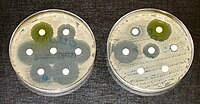
Photo from wikipedia
Background The contribution of community and hospital sources to the transmission of extended-spectrum β-lactamase producing Enterobacterales (ESBL-PE) remains elusive. Aim To investigate the extent of community dissemination and the contribution… Click to show full abstract
Background The contribution of community and hospital sources to the transmission of extended-spectrum β-lactamase producing Enterobacterales (ESBL-PE) remains elusive. Aim To investigate the extent of community dissemination and the contribution of hospitals to the spread of ESBL-PE by exploring their spatiotemporal distribution in municipal wastewater of the central European city of Basel. Methods Wastewater samples were collected monthly for two consecutive years throughout Basel, Switzerland, including 21 sites across 10 postcode areas of the city collecting either community wastewater (urban sites, n = 17) or community and hospital wastewater (mixed sites, n = 4). Presumptive ESBL-PE were recovered by selective culture methods. Standard methodologies were applied for species identification, ESBL-confirmation, and quantification. Results Ninety-five percent (477/504) of samples were positive for ESBL-PE. Among these isolates, Escherichia coli (85%, 1,140/1,334) and Klebsiella pneumoniae (11%, 153/1,334) were most common. They were recovered throughout the sampling period from all postcodes, with E. coli consistently predominating. The proportion of K. pneumoniae isolates was higher in wastewater samples from mixed sites as compared to samples from urban sites, while the proportion of E. coli was higher in samples from urban sites (p = 0.003). Higher numbers of colony forming units (CFUs) were recovered from mixed as compared to urban sites (median 3.2 × 102 vs. 1.6 × 102 CFU/mL). E. coli-counts showed moderate correlation with population size (rho = 0.44), while this correlation was weak for other ESBL-PE (rho = 0.21). Conclusion ESBL-PE are widely spread in municipal wastewater supporting that community sources are important reservoirs entertaining the spread of ESBL-PE. Hospital-influenced abundance of ESBL-PE appears to be species dependent.
Journal Title: Frontiers in Microbiology
Year Published: 2023
Link to full text (if available)
Share on Social Media: Sign Up to like & get
recommendations!